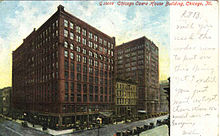- Chicago Opera House
-
Chicago Opera House 
The Chicago Opera House ca. 1885-95General information Type Offices and Theater Location Chicago, USA Coordinates 41°52′59″N 87°37′53″W / 41.8830°N 87.6313°WCoordinates: 41°52′59″N 87°37′53″W / 41.8830°N 87.6313°W Completed 1885 Destroyed 1912 Design and construction Architect Cobb and Frost The Chicago Opera House, (constructed in 1884–5) was a theater complex in Chicago, Illinois, USA, designed by the architectural firm of Cobb and Frost.[1] The Chicago Opera House building took the cue provided by the Metropolitan Opera of New York[2] as a mixed-used building: it housed both a theater and unrelated offices, used to subsidize the cost of the theater building. The theater itself was located in the middle of the complex and office structures flanked each side.[1] The entire complex was known as the "Chicago Opera House Block," and was located at the Southwest corner of W. Washington Ave. and N. Clark St.
The Chicago Opera House was opened to the public on August 18, 1885. The first performance in the new theater was of Hamlet starring Thomas W. Keene.[3] From 1887 to 1890, the Chicago Opera House served as the official observation location for recording the climate of the city of Chicago by the National Weather Service.[4]
The theater suffered a fire in December 1888, which mainly damaged portions of the roof. However, the roof was repaired, and most of the exterior of the building remained undamaged. During its existence, the Chicago Opera House was the site of the premiere of several successful musicals such as Sinbad and The Arabian Nights.[5]
The Chicago Opera House was demolished in 1912. The site is currently occupied by the Burnham Center (formerly known as the Conway Building), completed in 1915.[6]
Construction
The idea for the Chicago Opera House came from Scottish-born newspaperman and financier David Henderson.[7] Henderson "planned the scheme and the stock— 550,000— was subscribed in six weeks. Thus Chicago had the first fireproof, steel constructed, electric lighted theatre in the country." [8] The construction of the Chicago Opera House was one of the earliest examples of general contracting, run by George A. Fuller.[9] Upon completion, the masonry-clad building was 10 stories and 140 feet tall.[9]
References
- ^ a b Carl W. Condit, The Chicago School of Architecture, University of Chicago Press, 1973, p. 59-60.
- ^ The Metropolitan Opera (J. Cleaveland Cady, architect, completed in 1883) did not house its mixed uses in a single structure, but in flanking buildings.
- ^ "The New Chicago Opera House." The New York Times. August 19, 1885. Full Text at [1]
- ^ "History of the Chicago and Rockford weather observation sites" From NOAA.gov
- ^ "A BIG THEATRE BURNING.; THE CHICAGO OPERA HOUSE THREATENED WITH DESTRUCTION." The New York Times. December 13, 1888. Full Text at [2]
- ^ Emporis
- ^ "Theater" At The Encyclopedia of Chicago. Retrieved from
- ^ Who's who on the Stage edited by Walter Browne, Frederick Arnold Austin, 1908 pg. 232.
- ^ a b Frank Alfred Randall and John D. Randall, History of the Development of Building Construction in Chicago,University of Illinois Press, 1999, p. 110
City of Chicago Chicago metropolitan area · State of Illinois · United States of America Architecture · Beaches · Climate · Colleges and Universities · Community areas · Culture · Demographics · Economy · Flag · Freeways · Geography · Government · History · Landmarks · Literature · Media · Music · Neighborhoods · Parks · Public schools · Skyscrapers · Sports · Theatre · Transportation
 Category ·
Category ·  PortalCategories:
PortalCategories:- Buildings and structures demolished in 1912
- Former buildings and structures of Chicago, Illinois
- Demolished buildings and structures in the United States
- Destroyed landmarks in the United States
- Houses completed in 1885
- Opera houses in the United States
- Chicago, Illinois stubs
Wikimedia Foundation. 2010.
